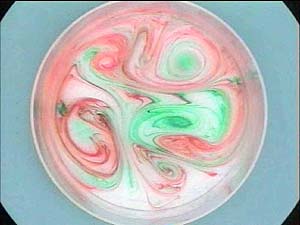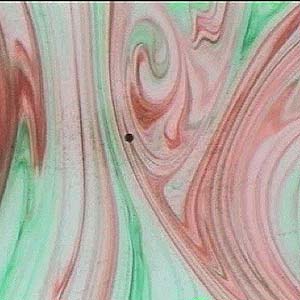The dye-stirring experiments described here vividly illustrate some of the remarkable properties of rotating fluids and particularly the rigidity imparted to them by rotation.
How to Carry Out the Experiment
We take our clear 16”x16” square container with its circular insert and place it dead center on a white board on the turntable. We fill the tank with water to a depth of 15 cm or so, set the rotating table turning anticlockwise (looking down from the top) at a speed of order 10 rpm (i.e. a period of 6 seconds or so). We allow the water in the rotating tank to attain solid body rotation for 10 minutes or so. Check for solid body rotation using a tiny amount of Potassium Permanganate.
When the tank is in solid body rotation, stir the fluid with your hand using a gently beating action. Try not to induce a systematic swirl, but don’t be too timid! Wait 10 seconds or so for things to settle down a little, but not long enough for the currents to die away. We observe the motion by introducing dye (food coloring) from a pipette. Only a small amount of dye is required. It is fun to try with two or three different colors.
It’s the initial evolution on which we should focus. As time proceeds convection commonly occurs as the water in the tank cools to the lab – and this will lead to smaller scales and ever more beautiful patterns.
It is instructive to contrast the beautiful patterns observed in the rotating experiment with dye patterns seen in a non-rotating experiment carried out in exactly the same manner. We observe the remarkable contrast between the evolution of the dye in the two experiments.
From the movie loop of the dye in the rotating frame, estimate the Rossby Number – see Section 7.1 here. Is the Rossby number large or small? See the table on measures of rotation rate for help on converting rotation rates.

